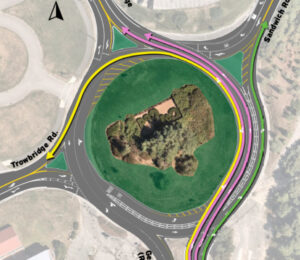 HYANNIS – Living with cancer often means coping with pain. Neurosurgeons at Cape Cod Hospital can deliver rapid relief to cancer patients suffering from hard-to-treat chronic pain with a treatment called OsteoCool, which uses cutting-edge technology to treat tumors that arise in the spine and may produce severe back pain and other problems.
HYANNIS – Living with cancer often means coping with pain. Neurosurgeons at Cape Cod Hospital can deliver rapid relief to cancer patients suffering from hard-to-treat chronic pain with a treatment called OsteoCool, which uses cutting-edge technology to treat tumors that arise in the spine and may produce severe back pain and other problems.
“The name OsteoCool is a misnomer,” said neurosurgeon David Leppla, MD, FAANS. “The word ‘cool’ makes it sound like we’re freezing the tumor, but we’re not. We’re actually heating it up.”
These painful spinal tumors usually occur due to a phenomenon known as metastasis, which happens when malignant cells break away from tumors and travel to other parts of the body. When malignant cells migrate, the destination is often bone, which is the third most common site for cancer metastases (behind the lungs and liver). As high as 60 to 80 percent of cancer patients develop bone metastases, which are most common in people diagnosed with breast, prostate, liver and lung cancer. Metastases can form in any bone in the body, but they most frequently arise in the central part of the body, especially in the vertebrae, which are the bones that form the spine. Spinal metastases can cause severe pain and increase the risk for fractures and other problems.
A New Approach:
Drugs can help control the growth of spinal tumors and ease the pain they cause in some patients, but these metastases frequently require more aggressive treatment. For years, the standard approach has been stereotactic radiosurgery, a non-invasive procedure that focuses beams of radiation from outside the body on a tumor, which damages the DNA of cancer cells. The cells gradually die off, the tumor shrinks and pain diminishes over time.
However, in recent years a new treatment option has emerged for patients with aching, often-debilitating spinal metastases. This technology, known as radiofrequency (RF) ablation, uses intense energy delivered by probes inserted into these tumors to destroy cancer cells within minutes. Treatment of spinal tumors with the OsteoCool RF ablation system is performed as an outpatient procedure, with patients usually on their way home an hour after the operation is completed.
Here’s how OsteoCool works.
After going through pre-operative preparation, the patient is sedated, brought to a neurosurgery suite and positioned face down on an operating table. An imaging device called a fluoroscope is directed at the patient’s body from both sides, which produces a kind of X-ray movie of the vertebra that will be treated. The image is projected on a monitor that the neurosurgeon views to guide the placement of instruments.
Destroying Tumor Cells
Next, the surgeon makes two small incisions in the patient’s skin, near the site of the spinal tumor. Thin tubes called cannulas are inserted into each incision and guided into cylinder-shaped vertebral structures called pedicles.
“That’s our entryway to get into the vertebral body,” explained Dr. Leppla.
Fine drills are threaded down each cannula and turned on to create access to the inside of the diseased bone, where the tumor lies. After withdrawing the drills, the surgeon inserts probes into the cannulas. The tips of the probes deliver an electric current and heat up to a temperature of 70 degrees Celsius (158 degrees Fahrenheit).
“That kills tumor cells in the bone,” said Dr. Leppla. “Meanwhile, the tip of the probe is irrigated with water to keep it from over-heating the tissue.”
Depending on the size of the vertebra being treated, the probes are kept in place for 11 to 15 minutes before the surgeon removes them. But the treatment is not yet complete, since destroying the tumor leaves the vertebra unstable. To remedy this problem, the surgeon inserts a device with a balloon on the tip into the bone. The balloon is inflated, then withdrawn—creating a cavity. The void is then filled with bone cement, a procedure called kyphoplasty.
“When bone cement solidifies, it’s as hard as a cue ball,” noted Dr. Leppla.
In 2018, a review of the scientific literature on radiofrequency ablation for treatment of metastatic spinal tumors published in the journal Pain Physician found the therapy to be effective pain treatment with a very low risk for major complications. Dr. Leppla observes that about 80 percent of his patients benefit from the procedure. He recently treated a woman who had already undergone radiation treatment for a tumor in her lumbar spine, or lower back. But the cancer had returned and spread, so she now had three tumors on her spine. Dr. Leppla treated all three with OsteoCool, and called to check on her the following day.
“She was delighted. She was giddy with the results,” he recalled. “Her pain relief was essentially instantaneous.”























